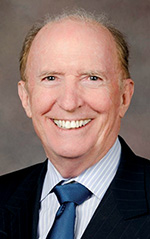Hello, Europe—America Is Back
The trans-Atlantic agenda goes beyond undoing Trump. Here is a sober look at the issues from a veteran diplomat.
BY ROBERT E. HUNTER
Joe Biden’s election as U.S. president was greeted with great relief by almost all Europeans. His first major foreign policy speech, at February’s virtual Munich Security Conference, added to European confidence as he declared, “America is back.”
There is much to be coming “back” from. Allied concerns about America under President Donald Trump stemmed only in part from his blustering style and retreat from American commitments abroad, including the World Health Organization, the Paris Climate Accord, the 1987 Intermediate-Range Nuclear Forces Treaty and work on the Trans-Atlantic Trade and Investment Partnership.
At least as important, if not more so, “America is back” is welcomed in Europe as repudiating Trump’s refusal to say he would honor the core U.S. commitment to European allies: the Washington Treaty’s Article 5, which declares that an attack on one signatory will be considered an attack on all. Ironically, if any ally had been attacked, it was virtually certain that Trump would have responded militarily, as being in America’s irreducible security interests; uncertainty, however, is the enemy of both confidence and deterrence.
Further, Trump had decided to reduce U.S. military forces in Germany. This was not particularly important in terms of combat power (given U.S. and other NATO allies’ military deployments in Central Europe), but symbolically it was immense. Biden immediately put that decision on hold.
Yet “America is back” only takes the United States, the alliance and U.S.-European relations so far. In his Munich speech, Biden said: “We are not looking backward; we are looking forward, together. It comes down to this: The trans-Atlantic alliance is a strong foundation—the strong foundation—on which our collective security and our shared prosperity are built. The partnership between Europe and the United States, in my view, is and must remain the cornerstone of all that we hope to accomplish in the 21st century, just as we did in the 20th century.”
An excellent beginning, but only that. There is an extensive trans-Atlantic agenda; meeting it is not just a matter of undoing Trump. The world has moved on.
The U.S. “Big Three”
Particularly important for Biden administration relations with Europe are the three big areas of U.S. concern about challenges to its security and other interests: Russia, Iran and China.
Russia. NATO will hold a summit on June 14 in Brussels. A key focus is the most recent alliance review, “NATO 2030,” a comprehensive study of NATO’s strategic environment and a long list of recommendations. Yet Russia will be the summit’s centerpiece, including European desires to help shape Biden administration attitudes and policies toward Moscow. The summit’s deliberations will ratify commitments and actions to reassure allied states, especially those nearest to Russia, and to make clear to Moscow that, on the fundamentals, the allies “do not divide.” The alliance will also take on all Russian power-projection challenges, including cyber security, emerging and disrupting technologies, and interference in Western democratic politics.
Still, formal allied agreement on opposing Russian ambitions in Europe (and elsewhere) is not as straight-forward as it may seem—certainly not as clear-cut as during the Cold War or even immediately following Russia’s 2014 seizure of Crimea and incursions into other parts of Ukraine, with intensified threats this year. During the last several years, the U.S. approach to Russia has been drifting, on a bipartisan basis, toward lasting confrontation, if not an actual cold war.
“Anti-Russia” will not suffice as glue for trans-Atlantic relations, even with understanding of U.S. preeminence in dealing with Moscow.
Trump took a progressively tougher line toward Moscow as he came under political attack for coddling Vladimir Putin. The possibilities for cooperation that Trump and Putin discussed at their July 2018 summit in Helsinki went nowhere when the U.S. media focused only on a belief about a cozy Trump-Putin relationship. President Biden has himself taken a hard line toward Russia, even though he has acknowledged the value of cooperating when possible and proposed to meet with Putin. (On the critical nuclear arms control agreement, New START, the two sides did agree in February to a five-year extension.)
The bottom line is that the United States is the only country with the weight to deal with Russia, and all the allies know it. Thus, keeping America “in” is still critical insurance and will continue to be so indefinitely. Yet the allies are not united in attitudes toward Russia. As a rule, the farther an ally is physically from the Russian frontier, the more flexible is its national position. Otherwise, in a significant difference with Washington, Germany plans to continue with the Nord Stream 2 natural gas pipeline under the Baltics from Russia, which Biden and the U.S. Congress have opposed, with the latter authorizing sanctions on firms working on the pipeline.
In the end, U.S. differences with some European countries on Russia and Vladimir Putin won’t pose a fundamental threat to ties across the Atlantic; but “anti-Russia” will not suffice as glue for trans-Atlantic relations, even with understanding of U.S. preeminence in dealing with Moscow. In the NATO combination of “deterrence plus dialogue,” Biden and his team have inclined more to the former, many Europeans to the latter. In the United States, domestic opposition to attempts to build a different future with Russia remains formidable, and there is so far no evidence that Putin would respond positively. For Biden, getting Russia policy right will entail considerable efforts with allies and other Europeans, as well as with Russia.
Middle East (focusing on Iran). Perspectives within the NATO alliance and the European Union, including between the United States and most European allies, diverge on some other “outside of area” matters. The Middle East and environs are the focus of at least two differences. The first is general: As the Biden administration seems to be following the Trump administration in wanting to reduce the U.S. footprint in the region (beginning with departure of U.S. and allied troops from Afghanistan by Sept. 11), it is likely to want Europeans to assume more responsibility for promoting Western interests in some other parts of the region. That will not be popular with most Europeans.
The second is specific. Ever since Trump in May 2018 withdrew from the 2015 Joint Comprehensive Plan of Action with Iran—a signal achievement of the Obama administration and a major contribution to regional security and stability—most Europeans have worried that the risks of crisis or even conflict would increase, especially when Iran subsequently began moving away from some JCPOA-agreed limitations on its nuclear program.
President Biden has consistently declared his commitment to rejoining the JCPOA, and this is popular in Europe. Like his predecessors, he has also expressed a desire to deal with other Iranian behavior beyond the “nuclear file,” notably Iran’s ballistic missile program, support for regional proxies from Yemen to Lebanon and what many Americans believe to be its leading role in promoting terrorism (largely ignoring Saudi Arabia’s role). Yet both Biden and his top officials long argued that, before the United States rejoins the JCPOA or reduces U.S. sanctions on Iran, the latter must first return to compliance with the agreement. In particular, Tehran must reverse uranium enrichment undertaken since May 2018.
Iran takes the opposite position: that the United States, having quit the JCPOA, must move first. Arm’s-length negotiations did start in March; but if they do not lead to a breakthrough, and America keeps its full sanctions regime in place, there will be major European misgivings because of the growing risks of a deepening crisis.
Few, if any, European states will sign on to the full U.S. agenda in dealing with China.
China. A further potential long-term problem for trans-Atlantic relations is China. There are already stresses within the alliance because the United States is “pivoting” significantly to Asia, as the Obama administration inelegantly put it, in order to face Beijing’s rising power, position and ambitions. Greater U.S. preoccupation with China than with Europe is a natural evolution of geopolitics and geoeconomics, even with Russia factored in. But the China issue will have an additional impact on U.S. relations with its European allies because, like its predecessor, the Biden administration expects the Europeans to follow the U.S. lead.
There is also a “do no harm” aspect—namely, U.S. concern over increasing Chinese economic penetration of European countries (and the European Union), as part of Beijing’s Belt and Road Initiative. This was underscored by the E.U.-China Comprehensive Agreement on Investment concluded two days after Biden’s inauguration. The Biden administration also wants the Europeans to support all elements of U.S. confrontation with China. Fortunately for Western comity, there is virtual unanimity on the need for the “Western” organization of international economic relations and rulemaking to prevail over any Chinese alternative. But few, if any, European states will sign on to the full U.S. agenda in dealing with China.
It was one thing for the alliance to send troops to Afghanistan after 9/11, when neighboring Russia was supine, to make sure the United States would not lessen its strategic interest in Europe. It would be quite another to give open-ended support for U.S. efforts to contain China, a major power that poses no security threats (e.g., terrorism) in Europe. Except where a clear common interest is established, the Biden administration will find few, if any, European takers.
Values and Interests: Nonmilitary Trans-Atlantic Issues
In addition to securing U.S. interests abroad, the Biden administration also wants to promote democracy, a second-order U.S. priority since the Obama administration. This has a values and ideology dimension, but it also has a geopolitical purpose, with China, Iran and Russia as key targets. To try building a common front with allied and partner countries, Biden has proposed a summit of democracies. At this writing, it is not clear that this idea has been thought through, including who gets invited and who does not (not a trivial matter!), what the agenda would be and what “deliverables” there would be in addition to rhetoric. Thus, a democracy summit contains risks, including in trans-Atlantic relations, if comity is not more or less guaranteed in advance.
Since the end of the Cold War, both security in Europe and trans-Atlantic ties have increasingly moved beyond NATO’s preeminence, although it remains the key institutional link across the Atlantic and is highly popular with the American people and Congress. Except for challenges and threats posed by Russia since 2014—significant in themselves—nonmilitary factors have become increasingly significant.
The matter of how security burdens and responsibilities are to be shared is significant.
Since early 2020, COVID-19 has been most important, and cooperation across the Atlantic has in general been positive: President Biden’s clarity and commitment on COVID-19 have been most welcome in Europe. But the same cooperation across the Atlantic (other than by Canada on the North American side) cannot be said about the dramatic rise in immigration to Europe from Africa and especially the Middle East, the latter to a great extent the result of the ill-conceived 2003 U.S.-led invasion of Iraq. Immigration has proved to be the most important source of political and social stress ever since within the E.U.
Burdened with its own immigration issues, the United States has done virtually nothing to help, and that continues true under Biden. Yet it is a key factor in one of the most important challenges facing the Western community as a whole: the falling away from democratic practice by some European countries, notably Poland and Hungary—ironically, two of the first three new NATO allies when the alliance began enlarging in 1999.
A suggestion made at the time that NATO create a mechanism for counseling laggards in democracy was rejected by the Clinton administration. And it is not possible to threaten these countries and their democratic leaders with expulsion from NATO; there is no provision for doing so.
NATO and the European Union
The European Union has major roles to play in European security in the broadest sense, including economic and political development in Central Europe and climate change. Yet relations between NATO and the E.U. remain woefully inadequate, despite evidence that “security” has to be seen holistically and that institutional North American–European ties must have a strong economic dimension (beyond the deep integration of much of the private sector on both sides of the Atlantic). Moreover, America’s links to the European Union, to which it does not belong, can’t compete with its NATO membership.
NATO obviously needs a robust relationship with the European Union. But this has advanced at a snail’s pace since, as U.S. ambassador to NATO in 1993, I coined the following aphorism: “NATO and the European Commission are two institutions living in the same city on separate planets.” Franco-American cooperation did lead to some ties between NATO and the Western European Union, now the Common Security and Defence Policy; but these have hardly progressed since then.
President Biden has a chance to demonstrate renewed U.S. leadership; but also important is engaging European efforts, which are far from guaranteed.
Notably, at the February Munich Security Conference President Biden made only one brief reference to the E.U.: “The United States will work closely with our European Union partners and the capitals across the continent—from Rome to Riga—to meet the range of shared challenges we face.” Meanwhile, although NATO Secretary General Jens Stoltenberg had little new to say on this subject, the “NATO 2030” report has sensibly proposed, as a beginning, a summit-level meeting between NATO and the E.U. countries—an idea I have pressed, without success, for every NATO summit since 1999. President Biden and the Europeans have a chance to get this right.
A cooperative and task-sharing relationship between NATO and the E.U. that recognizes the comprehensive, interconnected nature of security needs to be high on the agenda—not a “security” based on one or another “tool,” but an encompassing method with overall commitments and activities, both public and private.
The Issue of Burden-Sharing
The matter of how security burdens and responsibilities are to be shared is significant. Not surprisingly, given the Trump administration’s attitudes toward Europe, the decades-old idea of an independent European defense force gained added support. Two years ago, French President Emmanuel Macron asserted that NATO is experiencing “brain-death,” and that the E.U. should gain “military sovereignty” separate from NATO. As demonstrated by fledgling efforts in the 1990s, the two institutions can reinforce each other. Yet no one doubts that, if there were a military threat to Europe (i.e., from Russia), only NATO and the United States could act.
U.S. (and NATO) reluctance regarding separate European defense ambitions continues, as reflected in Stoltenberg’s comments at Munich: “Any attempt to weaken the trans-Atlantic bond will not only weaken NATO, but it will also divide Europe; so we have to have Europe and North America together in NATO. That’s the best way.” This concern should have been overcome long ago, both to help meet U.S. demands for greater European NATO burden-sharing and to lessen worries about U.S. steadfastness. Joe Biden has dramatically lessened European doubts fostered by Donald Trump; but what happens with the next U.S. president?
In the meantime, there will be renewed American appeals to get allies to “pull their weight” in defense spending. At its 2014 Wales Summit, NATO set a goal for each ally to spend at least 2 percent of gross domestic product (GDP) on defense, although it is certain that not all the allies—maybe not even a majority—will meet that goal by its putative deadline of 2024, despite overall allied spending on defense going up significantly. The goal was problematic from the outset: It said more about “inputs” than about “outputs,” and it failed to understand adequately that “security” in Europe is about many factors, of which military strength is only one. A far better goal would be, say, 3 percent of GDP—but with a significant part going to economic development of Central European countries, a key underpinning of the continent’s security.
Leadership Is a Two-Way Street
Secretary of State Antony Blinken has stressed the role of American leadership: bringing countries together “because they trust us to lead, and no one can unite others like we can.” This is an ambitious project, but it does not command automatic support in Europe. This is particularly so when it comes to “outside of area” engagements.
During the months ahead, President Biden has a chance to demonstrate renewed U.S. leadership; but also important is engaging European efforts, which are far from guaranteed. Biden’s earning renewed trust in the United States is the most basic facet of “America is back,” but it’s also true that “leadership,” cooperation and compromise are a two-way street. Both America and Europe need to take note.
Read More...
- “The Trans-Atlantic Partnership,” by Menzies Campbell, The Foreign Service Journal, April 2017
- “New US president: how EU-US relations could improve,” the European Parliament, January 20, 2021
- “Transatlantic Relations After Biden’s First 100 Days,” by Erik Brattberg, Carnegie Endowment, May 6, 2021





